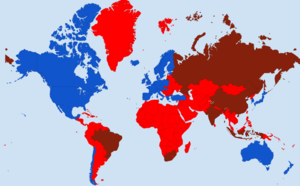OECD

OECD stands for the Organization for Economic Co-operation and Development. This is an organization concerned with the day to day good of people in countries around the world.[1] As stated on their own website:
- "The OECD provides a forum in which governments can work together to share experiences and seek solutions to common problems. We work with governments to understand what drives economic, social and environmental change. We measure productivity and global flows of trade and investment. We analyse and compare data to predict future trends. We set international standards on a wide range of things, from agriculture and tax to the safety of chemicals."[2]
The countries within OECD are often called OECD countries and can be grouped together because their economic infrastructure is fundamentally more extensive than countries that don't participate directly in OECD (called non-OECD countries, also called developing economies or modernizing economies). The difference in economic and energy infrastructure can be seen in the interactive graphs at the bottom of the page.
OECD as an organization
This international organization is based in Paris, France[3] and came out of the Organization for European Economic Cooperation (founded in 1948, to implement the USA's Marshall plan) but started including other countries as well. The OECD was founded (or re-branded) in 1961.[4] The organization includes 34 countries (the blue countries in figures 1) and 6 countries that cooperate but are not members of OECD (the dark red countries in figure 1); the red (light and dark) countries make up the non-OECD countries. [5]
Much like Energy Education, the OECD makes a great deal of data available to the public. For example, you can see data on Canada, the United Kingdom, or the USA (some data is available on all member and cooperating countries, with an entire suite of interactive charts devoted to seeing data in different ways).
OECD countries vs. non-OECD countries
Two major differences between OECD countries and non-OECD countries are the amount of primary energy that they consume and their population growth. The countries that participate in OECD tend to be wealthier countries and use quite a bit more primary energy per capita, as can be seen in the interactive graph below. You can also change the y-axis to GDP in order to see the difference in wealth.
Population growth is much higher in the non-OECD countries, as the interactive graph below shows. Keep in mind that the BRIC countries, Brazil, Russia, India, and China are considered non-OECD. Only 1/6th of the world's population lives in the OECD countries with most of the wealth and energy use:
To learn more about OECD please visit their website.
References
- ↑ The OECD's website has a great deal of information: oecd.org
- ↑ (2014, Oct. 30). About the OECD [Online}. Available: http://www.oecd.org/about/
- ↑ (2014, Oct. 24). Getting to the OECD [Online]. Available: http://www.oecd.org/site/conferencecentre/gettingtotheoecd.htm
- ↑ (2014, Oct. 30). History [Online]. Available: http://www.oecd.org/about/history/
- ↑ (2014, Oct. 24). Members and partners [Online]. Available: http://www.oecd.org/about/membersandpartners/#d.en.194378

